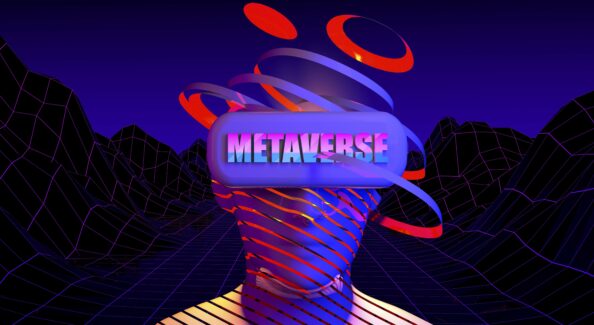
You must have heard of the Metaverse, haven’t you? It is not only a new way to spend our time online. Some experts and particularly marketers predict that the Metaverse has the potential to become the future of digital marketing, as it will unite applications, brands, businesses, people, services, and social networks within a single, real-time 3D environment.
Another buzzword these days is NFT. NFTs are a revolutionary technology that aims to increase engagement, retention, and revenue for the companies that implement it. What if we put the Metaverse and NFTs together? We have the answer: even more potential to help your business attract new customers, build loyal relationships, and stay ahead of the competition.
In this article, we’ll help you get acquainted with the Metaverse and NFTs, go into detail about their use cases and differences, and describe the most notable Metaverse projects and top platforms to find out if it’s worth our attention.
Metaverse is an immersive, shared, open, and interactive digital world that can be entered through a virtual reality headset. It consists of different virtual spaces, each providing access to specific services and solutions. The Metaverse is a 3D world that significantly reduces our need to travel and use physical resources.
The Metaverse is a stage for a variety of activities that users can experience through avatars, shared screens, and remote meetings. User avatars serve as virtual bodies that can be customized. In addition, users have virtual homes and can fill them with the items they love. All in all, users can interact with each other, work, play games, and do other activities that they do in real life.
In other words, the Metaverse is a 3D representation of the Internet. Surfing the web is like visiting a virtual supermarket with different shops and displays. In a 3D world, users can easily visualize and interact with any object. They can move between activities, chats, data, and locations with a simple gesture. In the Metaverse, everything is accessible and connected, so users don’t have to switch between applications and a web browser.
Digital Advertising
Digital advertising is becoming more prevalent around the world, and more and more companies are using it in their marketing campaigns. The metaverse offers a new way for companies to promote their goods and services within a real-world environment, making promotion more immersive and engaging than traditional digital ads.
Events and Conferences
Events and conferences can be held through virtual reality (VR) or augmented reality (AR), allowing people to participate in various events as if they were there in person.
Virtual Tourism
People can use the metaverse to create virtual tours of destinations around the world. This is a great opportunity for people who cannot travel for various reasons, such as difficult financial situations or busy work schedules. These tourists can enjoy the immersive experience of virtually exploring landmarks, monuments, and museums.
Education and Learning
The metaverse can be helpful for teachers who can use the technology to create interactive lessons that help students learn efficiently and retain information for a longer time. However, this is a relatively new trend in e-learning that is not yet widely accepted. Experts predict challenges in terms of student engagement, so there is much for learners and teachers to explore.
Real Estate
Real estate agencies have begun using virtual reality to give prospective customers an immersive look at apartments and houses they may be willing to buy or rent. With the metaverse, sellers can provide a more realistic experience than their competitors using traditional methods of prospecting. Finally, it prevents customers from wasting time touring properties that look different than they do in photos.
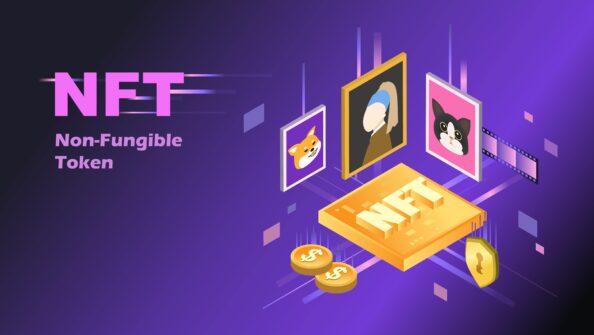
An NFT stands for a non-fungible token that is 100% unique and cannot be exchanged for another token without changing its value. NFTs represent the assets on a blockchain network or serve as digital certificates of ownership for those assets. Non-fungible tokens are created when a digital file is minted. Therefore, the certificate of ownership is generated by the cryptocurrency (most often Ethereum) and then given or sold to the new owner.
Each NFT contains a unique digital signature or identity, which makes it a one-of-a-kind item that exclusively belongs to its owner. Most NFT projects exist on the Ethereum blockchain, but ETH is not the only blockchain that holds NFTs. Crypto enthusiasts can buy and sell NFTs directly from creators through minting or on various exchange platforms that act as auction houses.
The most popular NFT categories include artwork, collectibles, domain names, music, sports memorabilia, video game assets, etc.
Both NFTs and the Metaverse are gaining popularity and attention from the crypto community. Let’s look at real-world use cases for this new type of token.
Digital Collectibles
A digital collectible is a digital item that users can own and trade with other users through a blockchain network or platform. These collectibles can also be traded for fiat money or other digital currencies via crypto exchanges. For example, a movie studio could create digital collectibles for their movies and sell them as official merchandise for cryptocurrency or fiat money.
Immutability Tokens
NFTs are unique digital assets that remain unalterable and cannot be adjusted once created. For this reason, NFTs are ideal for recording property rights and other documents that should be continuously stored on the blockchain. With this type of token, users can prove that they are the creator or owner of certain assets.
Game Rewards
Games tend to have their own internal economy that runs parallel to the real world. Players can buy digital items and trade them with other players within the game or sell them on an open market.

Digital Identity
Blockchain technology offers immutable and secure solutions for storing your personal information and documents in a decentralized database. Compared to centralized databases, decentralized databases are less susceptible to phishing attacks and data breaches. It is a great way for you to prevent sensitive data from being attacked or stolen, as all personal data remains encrypted on the blockchain.
Entertainment
The entertainment industry is gradually adapting to the digital age. NFTs can be used as access passes or tickets for events held in concert halls or sports stadiums.
NFTs are commonly associated with websites and transactions that occur through web browsers, while the metaverse is mostly VR-based. As a result, there may be some confusion about their similarities and use cases. Although both concepts are relatively new, there are some creative and effective ways to use NFTs and the metaverse simultaneously.
Virtual marketplace
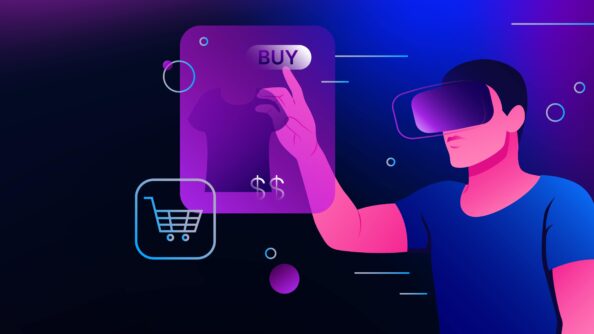
A virtual marketplace is a great way to use NFTs in the metaverse, as its users can easily buy and sell digital assets. Sellers can easily provide links and previews of assets on the web and mint assets directly in the VR space. In addition, users can create exclusive items that only exist within a virtual world or game to attract collectors looking for rare items.
Art gallery
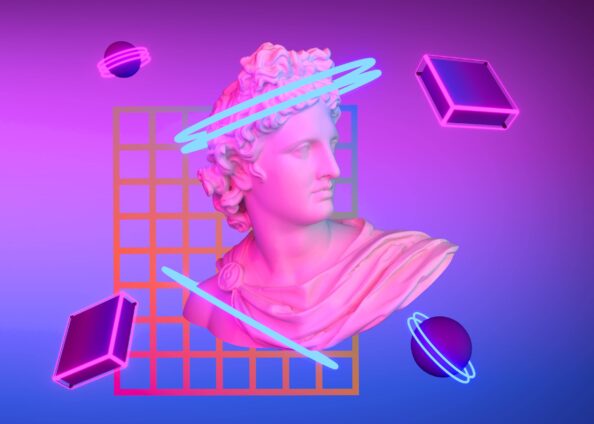
The metaverse can be used as an art gallery where people can view artwork in detail and from every angle and buy digital art using NFTs. NFTs can represent pieces of art that can later be rented or sold. This is not a marketplace, as prices are already set and not negotiated, all assets are of one type, and artists can be paid directly by their fans without intermediaries.
New frontiers
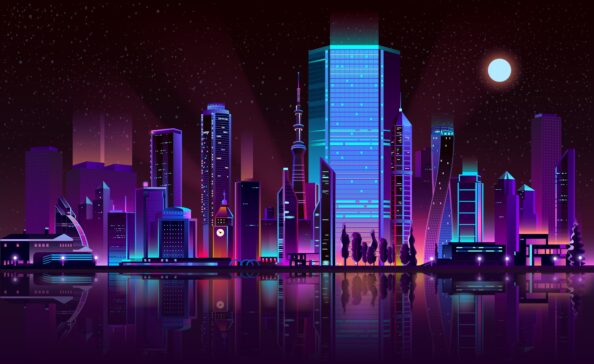
Real estate can be a very profitable industry in both the real world and the metaverse. Mostly it refers to digital land that can be sold in parts or completely for further user development.
Decentraland is a good example to illustrate the case. It is a virtual territory where everything is represented in 3D, and users can sell pieces of land as NFTs. What’s more, Decentraland has its own cryptocurrency.
The Metaverse: This term describes an interconnected virtual universe, also known as a 3D web. Multiple virtual spaces, each with its own governance and rules, make up the metaverse. The metaverse is like the advanced Internet, providing advanced interactions between applications and users.
NFTs: NFTs are a type of digital asset that can be utilized by different users. Every non-fungible token has a unique identifier that helps distinguish one token from another.
The Metaverse: This concept stems from various ideas about the potential future of technologies that will transform the human experience. The term “metaverse” was introduced in the 1992 science fiction novel Snow Crash by Neal Stephenson.
NFTs: CryptoPunks and CryptoKitties are the pioneers who created the first major NFT art projects in 2017. They attracted a lot of attention and created hype for NFTs. From that moment on, many other non-fungible token platforms were launched, and not all of them were successful.
The Metaverse: It is a virtual reality platform that allows people to create and share virtual experiences. It enables cross-chain communication and transactions, creating additional use cases such as social media platforms, asset exchange, gaming, etc.
NFTs: Metaverse NFTs are limited to a single chain. Asset collections from different platforms cannot communicate with each other unless they share the same contract address.
NFTs: Non-fungible tokens are accessible to anyone with a smartphone and access to the Internet. Therefore, the majority of users can easily access NFTs. However, VR and XR systems are the only areas where non-fungible tokens are less accessible than their metaverse analogs.
The Metaverse: NFTs lack the support of VR and XR systems, so these tokens are not as accessible as their metaverse analogs. Users cannot easily access the metaverse, whereas any smartphone can provide access to NFT marketplaces such as OpenSea.
Now that you know the basics of the Metaverse and NFTs, let’s take a look at the top Metaverse projects to keep an eye on if you’re looking for a project to invest in.
Decentraland
Decentraland is a successful metaverse project built on the Ethereum blockchain. In other words, it is a 3D virtual world that users can access directly from a web browser. Decentraland allows users to build, buy, explore, sell, and manage their virtual property.
The Decentraland metaverse is completely user-owned, providing individuals with interactive opportunities. Users have the flexibility to create their own avatars, applications, digital infrastructure, marketplaces, and settings. They can also participate in events, create new businesses, shop, meet new people, play games, and much more.
The virtual property in Decetraland is called land. Each plot of land in the digital world is minted as a non-fungible ERC-721 token. A plot of land is called a parcel, which is 52 feet wide and 52 feet long. The world of Decentraland consists of 90,601 parcels of land, which can be combined into larger Estates or purchased.
An Estate is another ERC-20 token that represents combined parcels of land that can be purchased together. Users can buy, sell, and rent virtual properties on the Decentraland Marketplace using MANA, an ERC-20 token that serves as Decentraland’s native cryptocurrency. It can be purchased through several leading crypto exchanges.
The platform has added the integration of eCommerce solutions, making it an important target for advertising and marketing. We expect Decentraland to continue to thrive and attract more investment, as users don’t need to own NFT or cryptocurrency to start exploring the metaverse.
The Sandbox
The Sandbox is an open-world video game built on the Ethereum blockchain. It is focused on developing original content and a play-to-earn metaverse. Like Minecraft and Roblox, The Sandbox implements a 3D voxel graphics style to provide players with many customization features. Anyone can create, manage, and monetize their game experience using SAND, the platform’s native cryptocurrency.
SAND is an ERC-20 token that serves as the in-game governance token for The Sandbox. Users have already created over 70 million unique environments, worlds, and wearables, shaking up the NFT market.
The Sandbox also allows its users to create assets, games, and applications on top of their land parcels. LAND is an ERC-721 token with a total collection of 166,464 pieces. Players can purchase and trade LAND on NFT marketplaces such as OpenSea. Platform members can also purchase multiple parcels of LAND and rent them out to other players.
The project has partnered with several celebrities and brands, including Snoop Dogg, The Walking Dead, and CryptoKitties, to offer exclusive experiences in their 3D virtual world.
Axie Infinity
Axie Infinity is a trendy play-to-earn metaverse game powered by NFTs and based on the Ethereum blockchain. It allows players to earn SLP (Smooth Love Portion) tokens by completing tasks and performing well in player-versus-player battles. The game revolves around Axies — charming animal-like creatures represented by NFTs.
Axies build virtual items, participate in battles, and hunt for in-game treasures. Players can collect different Axies and use them in ‘Axie Battles’ — a play-to-earn feature that allows users to compete for rewards by using their avatars in competitions. In addition, players can breed multiple Axies to create new Axies and expand their NFT collections, as each Axie has unique genetics and character.
In addition to SLP tokens, which can be earned in battles or adventure modes and used to breed Axies, there are also AXS tokens and LAND. LAND is another tradeable NFT within Axie Infinity. It represents a digital piece of virtual land within the game’s metaverse. Axie Infinity Shards (AXS) is a governance token that allows its holders to vote on the game’s future development plans.
Metahero
Metahero is a metaverse crypto project designed to create an ultra-realistic metaverse. Metahero allows users to scan themselves and real-world objects into the metaverse. The hyper-realistic and digitized reproductions of real-world objects are the most attractive to users. HERO is Metahero’s native ERC-20 token used to interact with the metaverse and pay for scanning services.
Metahero uses Wolf Digital World’s scanning technology to create 3D representations of people. Wolf Digital World is the industry leader in scanning technology used by renowned game companies such as CD Project, the company behind The Witcher series and Cyberpunk 2077.
Somnium Space
Somnium Space is a 3D blockchain platform focused on virtual reality experiences. It is available on both mobile and desktop devices. Somnium positions itself as an open, social, and persistent virtual reality platform where users can live, communicate, engage in eCommerce and entertainment, and more.
Unlike most metaverse projects, Somnium Space has adopted a multi-chain strategy using the Solana blockchain. It allows users to build an NFT gallery, use a VR avatar to attend VR concerts while dancing with a full body tracking kit, and develop new NFT-based worlds and experiences for others to enjoy.
Somnium Space also features an ERC-20 token CUBE that facilitates in-game transactions between players. They can purchase virtual items, rent land, and pay for metaverse events, games, goods, and services.
What’s more, Somnium is backed by Gemini, Microsoft, OpenSea, and other crypto giants.
Gala
Gala is a blockchain-based gaming platform that allows players to freely exchange in-game assets, giving them more control over the gaming experience. The platform offers several blockchain-based games that position themselves as social games, with a focus on connecting players and building relationships between them. Some of the games currently available include Echoes of Empire, Fortified, Mirandus, Spider Tank, and Town Star.
The metaverse has a native token, GALA, which is used on the platform to provide network governance and prizes and stimulate node operators. In addition, GALA is used to purchase digital items, such as NFTs, through the player marketplace and in-game stores. Gala users can create and customize their avatars, just like in any other blockchain-powered game in the crypto market.
ApeCoin
ApeCoin is one of the latest metaverse coins to enter the crypto domain. Shortly after it was created and distributed to BAYC NFT holders, the producer of the Bored Ape Match Club NFT collection announced the launch of a new metaverse crypto project based on the ApeCoin token. This dramatically increased the value of the APE token, making it the largest metaverse coin by market capitalization.
Since then, it has dropped more than 80%, but ApeCoin is still one of the largest metaverse coins by market capitalization. ApeCoin is managed by a decentralized autonomous organization (DAO), so every holder of the coin can vote on governance decisions.
ApeCoin is a coin with a variety of functions that gives its owners access to special events, games, goods, and services. It is an ERC-20 token, which means it can be used to make payments on the Ethereum network. ApeCoin already serves as an NFT incentive, and BAYC holders receive free APE that they can redeem immediately.
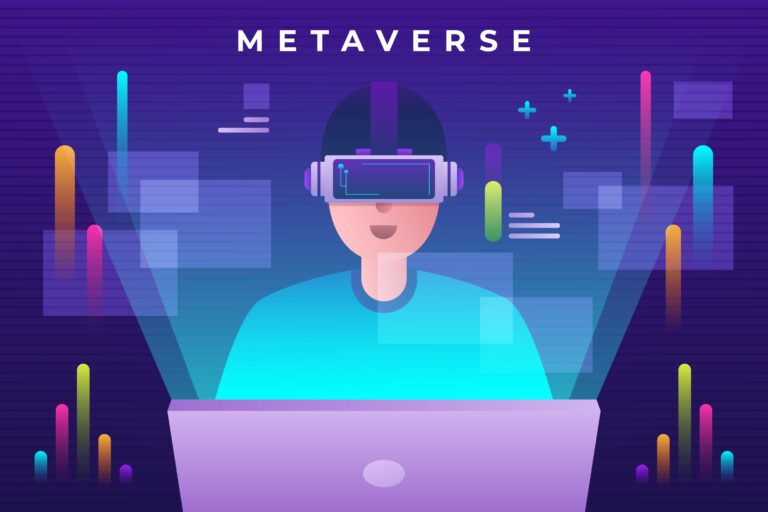
Souls of Nature
Souls of Nature is a new NFT project that aims to revolutionize the current metaverse landscape. It is both a metaverse game and a complete metaverse project with its own tradeable NFTs. The collection consists of 9,271 NFT animals that serve as avatars in the metaverse. It aims to help endangered species and their ecosystems.
Most play-to-earn games are simple and don’t offer anything special in terms of user experience. Souls of Nature uses Unreal Engine to create a unique user experience. The implementation of industry-leading technology makes it possible to create a truly immersive user experience. The experience involves the user being reborn as an animal and embarking on a journey to save the endangered world. Souls of Nature is the first HD Metaverse of its kind.
Souls of Nature strives to help the world and protect Mother Nature, so the team claims that a percentage of the funds raised from the debut collection will be donated to protect endangered ecosystems. This is a great way to give back and improve the world around us because blockchain technology consumes a lot of electricity.
Souls of Nature has a clear roadmap and defined plans for future development. The team plans to build an in-game marketplace that will allow users to trade items using the upcoming $ZOOIE currency.
Otherside
Otherside is a metaverse project from Yuga Labs, the team behind the popular Bored Ape Yacht Club (BAYC) NFT collection. Due to the success of that collection, Yuga Labs was able to fund the Otherside project, which will include a rich 3D world where players can use NFTs as avatars. This could include NFTs from the CryptoPunks, Bored Ape Yacht Club, and Kennel Club collections.
Although the Otherside metaverse is not yet playable, players have briefly experienced it through demos. So far, the reviews have been extremely positive, as the platform is capable of handling 10,000 players simultaneously. The key to this power is the underlying technology provided by Improbable, a company specializing in metaverse technology.
Otherside will have its own metaverse and NFT collections, including Cool Cats, World of Women, etc. The metaverse will be similar to an open-world game, allowing collectors to own land and interact with different ecosystems and their inhabitants.
The Otherside metaverse will integrate NFTs in several ways. As you already know, players can use their NFTs as 3D avatars. In addition, NFTs called Otherdeeds represent land in the Otherside. Finally, the Otherside metaverse is also considering the implementation of ApeCoins.
Yuga Labs expects the Otherside to be as popular as the Bored Ape Yacht Club NFT collection.
Star Atlas
Star Atlas is a virtual world that includes elements of strategy games, space exploration, territorial conquest, political dominance, etc. The game is set in the future, the year 2620, where players can conquer territories and obtain resources in a futuristic scenario. It is built on Unreal Engine 5 technology, which allows for high-end visuals. The metaverse also has features that ensure user protection and digital security.
Mud, Oni, and Ustur are the three main factions in the Star Atlas universe. Players can join a faction and help it become dominant. The game is still in active development, so the gameplay is not yet ideal. However, enthusiastic players can participate in demos.
In-game assets are represented as NFTs on the Solana blockchain. They include access credentials, housing, resources, ships, etc. Two game tokens control all game activity in Star Atlas: POLIS and ATLAS. POLIS is a governance token that allows its holders to vote on decisions regarding the further development of the metaverse. ATLAS is a utility token that allows players to participate in battles, explore different worlds, and earn the token by playing the game.
The Star Atlas metaverse has partnered with MoonPay, a cryptocurrency payment infrastructure startup, to enable credit card purchases of NFTs and ATLAS. In addition, MoonPay will facilitate fiat-to-crypto payments throughout the Star Atlas ecosystem.
Wilder World
Wilder World is a 3D metaverse platform that features top-notch visuals powered by Unreal Engine 5 technology. The platform’s awesome graphics have made it one of the most long-awaited new metaverse projects.
The Wilder World platform uses NFTs to represent in-game assets such as cars, houses, clothes, and land in its futuristic digital world. The project raised $3 million in a private token sale, including Animoca Brands and other notable investors.
Wiami is the center of this metaverse, and as the name implies, it was inspired by the city of Miami. The futurism is turned up to the maximum to harmonize with the overall vibe of Wilder World.
The platform’s ecosystem also includes a fungible token called WILD, which is primarily used in governance.
My Neighbor Alice
My Neighbor Alice is a metaverse game that allows players to build and farm on virtual islands. It is different from other metaverse worlds, as they usually have a futuristic and gloomy vibe, while My Neighbor Alice is cartoon-inspired and looks charming.
The game uses NFTs to represent in-game assets, including houses, land, and pets. It also relies on the BNB Chain blockchain platform for its NFTs.
My Neighbor Alice has a native token called ALICE, which is used for governance and staking and serves as the in-game currency. The game also features a play-to-earn aspect, so users can earn ALICE tokens by completing in-game tasks.
When My Neighbor Alice was featured on the Binance Launchpool, users could stake BNB, BUSD, and CHR tokens to earn ALICE tokens.
Gods Unchained
Gods Unchained is a trading card game where the cards are represented as NFTs on the Ethereum blockchain. Its gameplay is inspired by classic trading card games, most notably Magic the Gathering and Hearthstone. Gods Unchained has tactical gameplay that makes it stand out from other blockchain-based games by focusing on NFTs and gameplay at the same time.
The game’s ecosystem also includes GODS, which is its native fungible token. Its owners can use their tokens to mint new NFTs or purchase packs of virtual cards.
Bloktopia
Bloktopia is a metaverse project that utilizes the Polygon blockchain. The core of the Bloktopia world is a 21-story skyscraper that pays tribute to the 21 million maximum supply of Bitcoin. The project relies on the Unity game engine and its underlying technology.
In Bloktopia, users can own virtual real estate through NFTs and monetize their property by advertising or hosting exclusive events. The Bloktopia team claims that the virtual world will also include numerous educational resources for cryptocurrency users.
League of Kingdoms
League of Kingdoms is an MMO strategy game that uses NFTs to allow players to own in-game assets. In this game, players can buy land just like NFTs on the Ethereum blockchain. It also features Drago, a mythical creature that is represented as tradeable NFTs.
In League of Kingdoms, players start with small towns and grow them into breathtaking kingdoms. Users can also unite to form powerful alliances.
In early 2022, when the project held a token sale on the Binance Launchpad platform, the game was introduced to many crypto enthusiasts. After selling its native LOKA tokens on Binance Launchpad, the project raised $4 million.
As the name suggests, Voxels is a metaverse world that uses a voxel-based graphics style, resulting in a relatively lo-fi experience. The Voxels world has a Roblox-like design and focuses on the metaverse NFT real estate. Players can access and explore the virtual world directly from their web browsers, even if they don’t own NFT.
The Voxels world is divided into a series of parcels of land, named similarly to real-world streets, giving this metaverse a more homely feel in comparison to other platforms. Players can build, develop, and trade their virtual properties just as they would in the real world. What’s more, users can purchase NFTs, which represent custom wearables, to dress up their avatars.
RobotEra
RobotEra is a metaverse that allows players to earn crypto while building in a virtual world. The project has a native token called TARO. It is an ERC-20 token whose holders can vote on decisions related to the future development of the project. Since TARO is a utility token, its owners can stake the token for crypto rewards.
Land, player avatars, and robot companions are represented by NFTs to facilitate trading and increase transparency. RobotEra also includes an internal NFT marketplace, allowing users to buy and sell NFTs directly within the ecosystem.
Because assets in the metaverse are tokenized, there are many ways to earn money. RobotEra has many customization tools, so players can build and rent concert halls, office buildings, and play-to-earn games, limited only by their imagination. Finally, the metaverse allows players to mine resources that can later be used to create NFT-based robot companions and sold for crypto on the internal NFT marketplace.
MetaCity
MetaCity is an Ethereum-based virtual world that is also part of the Humans of the Metaverse (HOTM) NFT collection. MetaCity aims to operate as a decentralized web3 city where users can participate using various blockchain-based protocols. The platform allows users to create their own experiences, just like The Sandbox and Decentraland do.
In this world, there are several impressive ways for HOTM owners to spend $HOTM and interact with other users. The collection consists of virtual land that players can build on. The collection of land that users can build on sold out quickly in the first quarter of 2022. However, new users can still purchase land on secondary markets such as OpenSea.
For example, there will be a bank that will act as a Decentralized Autonomous Organization (DAO) and a museum that will serve as an NFT launchpad for emerging artists to make a name for themselves.
Although MetaCity is a relatively new project, it is already expanding. The team behind MetaCity has a clear roadmap for further improvements. Things are moving fast, so the future of the platform seems bright.

Now that you know the basics of Metaverse NFTs, you may be ready to purchase your own tokens. Buying one can be time-consuming and difficult if you don’t know where to start. Here are some steps to follow when purchasing Metaverse NFTs.
Step 1: Choose a crypto wallet. First, you need to select your preferred wallet and visit its official website. Look at the URL to make sure you are not visiting malicious resources.
Step 2: Install and set up the wallet. To install a cryptocurrency wallet, you need to click the download button on the wallet’s official website. You can also find installation instructions or even video tutorials there. This process takes a few minutes.
Step 3: Create a password and download your private key. For maximum wallet protection, you need to create a password that is different from your private key. A strong password should be difficult to remember and contain a mix of letters, numbers, and special characters. Don’t forget to write it down somewhere safe.
The wallet will remind you to download your private key. You can’t share it with anyone because that person would have full control over your crypto wallet. The best option is to store the key on an external hard drive that is not connected to the Internet so that malicious actors cannot compromise the offline storage.
Step 4: Buy crypto. Once you’ve created the wallet, you’re ready to buy cryptocurrency. You can go to a regulated broker or buy digital currencies through a cryptocurrency exchange. The purchase process is not complicated, just enter the desired amount, and you’ll find the funds in your portfolio.
Step 5: Transfer funds to your wallet. Once you set up your account, you’ll receive a wallet address. It is a string of 64 characters that holds the data related to your wallet on the blockchain. Go back to the crypto trading platform with the wallet address and send funds to your wallet. Send a small amount first to verify that you have the correct information. After verification, transfer the remaining amount.
Step 6: Connect your wallet. The funds have arrived in your wallet, so you need to connect the wallet to NFT LaunchPad. Just visit the NFT LaunchPad website, press the purple button with a wallet icon, click the icon of your wallet, and confirm the connection on the wallet page.
Step 7: Buy Metaverse NFTs. Click on the search bar, enter the name of the collection, select an NFT, press the ‘Buy’ button, review the details, and press ‘Pay’. The funds will be taken, and the NFT will appear in your connected wallet.
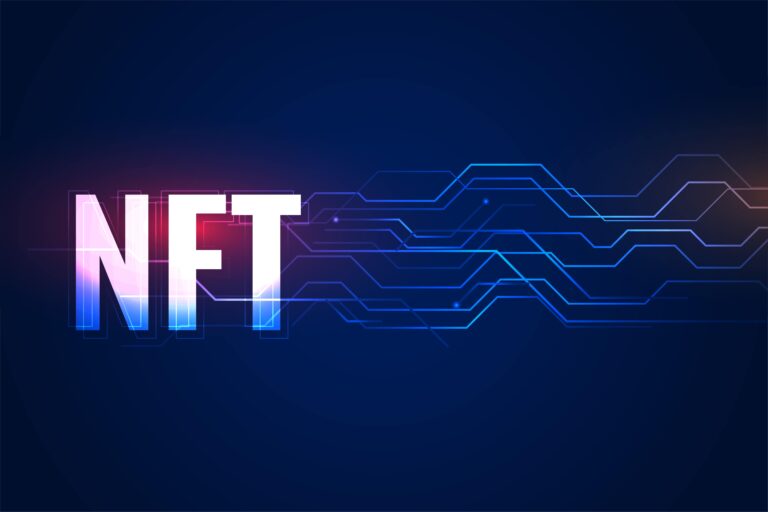
If you are interested in starting your own NFT and Metaverse projects to profit from Web3, here are some steps to help you get started.
Discovery Phase
In the beginning, the client needs to share their business requirements and goals with a team of developers. After that, developers analyze your needs and objectives to create a proposal that describes the development process and its steps.
Assembling the Team
To successfully implement NFT with Metaverse, you need an experienced team of developers who have delivered custom software solutions to companies in a variety of industries. You also need designers to create eye-catching and modern user interfaces. Finally, you need testers to catch and fix bugs that may arise during the development process so that the customer experience is not disrupted once the product is released.
Design and Development
This stage includes all the processes necessary to turn your idea into a working product. Building the initial prototype or minimum viable product (MVP) can take some time depending on several factors, including the complexity of your idea, the number of features you want to implement, and more.
Testing and Quality Assurance
You can use manual testing methods or automated testing tools. If you find bugs or errors while testing, you should fix them as soon as possible before releasing the product. You can hire our experienced development team that can quickly resolve any issues.
Continuous Improvements and Updates
There is always room for improvement, even after the product is released. You can continually enhance or upgrade existing features within the codebase to improve your product.

Let’s have a look at the most popular NFT social platforms and their influencers.
Afterparty
Afterparty is a platform that hosts a digital community of artists and creators. This platform allows creators to collaborate and engage with their audience.
The Afterparty platform opens the way for creator-centric NFT platforms, allowing artists and their followers to engage through various events and experiences. Afterparty celebrates artists, musicians, and other creators and gives them a place to interact with their fans.
For example, the platform hosts the annual NFT Art + Music Festival, which features musicians from a variety of genres. Kid Laroi and The Chainsmokers were headlining the 2022 festival.
TikTok
YouTube
OpenSea
OpenSea is the largest decentralized marketplace that hosts many popular NFTs, including art, music, photography, sports, trading cards, etc. The platform allows users to create, buy, and sell unique NFTs. OpenSea is user-friendly for beginners, as anyone can set up an account and start browsing NFTs within minutes. The platform accepts payments in many cryptocurrencies and doesn’t support fiat currencies.
Rarible is a creator-centric NFT marketplace built on Ethereum. The platform allows users to buy and sell digital art, collectibles, video game assets, and many types of NFTs. Rarible gives artists and creators complete ownership over their tokens and the trading process. The marketplace also provides helpful guides for new users and follows a decentralized mindset.
NBA Top Shot
NBA Top Shot is an open, basketball-focused NFT marketplace that allows users to buy, sell, and trade the best official highlight videos from NBA games. The platform is built and managed by the NBA, so users always know they are dealing with a trusted organization. NBA Top Shot is one of the most accessible platforms with low fees and no cryptocurrency required.
Binance, known as one of the largest crypto exchanges, launched an NFT marketplace in 2021. The platform offers a variety of digital assets, including art, gaming items, and digital collectibles. Binance is a user-friendly platform that only charges a 1% trading fee. What’s more, the platform runs on its own blockchain.
Nifty Gateway
Nifty Gateway is a gas-free NFT marketplace that focuses on artworks, especially those created by top artists and celebrities. The platform uses an “open editions” system to stimulate demand. This allows users to purchase editions for a limited time only when a new type of NFT is released. Nifty Gateway accepts credit card payments.
SuperRare is a premium NFT art marketplace that positions itself as an art gallery. The platform is highly selective with NFT submissions and spends a great deal of time reviewing works before making them available for sale. SuperRare is an ideal option for investors who want to be assured of NFT quality. The marketplace adds a 3% fee to each transaction, which is paid by the buyer.

Before you decide to invest in Metaverse NFTs, you should analyze the benefits of such an investment. The following sections will help you understand if investing in NFTs is worth your attention.
Long-term growth
Experts at McKinsey and Co. expect the Metaverse to reach a market capitalization of $5 trillion by 2030. However, after a boom in the Metaverse NFT sector in 2020 and 2021, the prices of the top NFTs fell the following year. While there is no guarantee of future returns, long-term investors may find such price corrections a great opportunity to reinvest in the market.
Entry into in-game competitions
Metaverse NFTs appeal to the GameFi industry, which is an integration of gaming with decentralized financial protocols. In this way, players can participate in the best Metaverse NFTs to earn rewards.
For instance, Lucky Block allows users to win prizes by participating in NFT drawings. Players must have exclusive Lucky Block NFTs in their wallets. To access multiple play-to-earn games, users must purchase NFT passes.
Multiple income streams
In the cryptocurrency industry, investing in Metaverse NFTs is a great way to create multiple income streams. For example, players who earn NFTs on platforms such as Axie Infinity, Lucky Block, etc., can trade these digital assets on OpenSea or other NFT marketplaces.
In addition, Tamadoge and some other metaverse games give cryptocurrency rewards to top performers on their platforms. For example, Tamadoge Pets can be used in competitions, while top performers are rewarded with TAMA. Users can exchange these tokens for fiat currencies or other digital assets on the OKX exchange.
Moreover, several metaverse projects, such as Battle Infinity, offer other use cases, including decentralized exchanges, NFT marketplaces, and staking options. Depending on the lock-up period, Battle Infinity users can earn between 12% and 25% APY.
Metaverse NFTs typically involve creating a virtual world and trading digital assets such as avatars, land, and wearables. Players can easily buy and sell these NFTs on marketplaces with the potential to make a profit.
Nevertheless, metaverse NFTs are still a growing sector in the blockchain world. Much of their value is based on speculation, as the virtual worlds behind them are not yet fully developed. Some projects may not even get off the ground, rendering their NFTs worthless. Hence, you need to be careful.
If you’re looking to invest in Metaverse NFTs, start with a blockchain consultation. Don’t hesitate to contact our experts, who will help you get the most out of your investment.